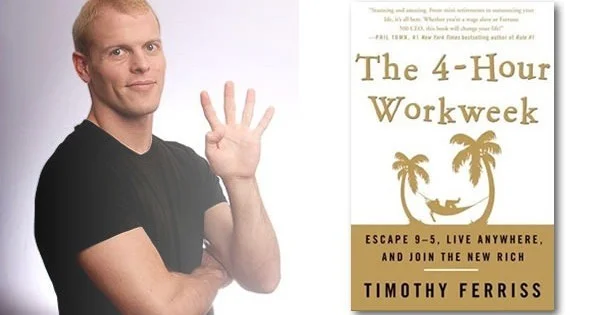The term “Tim Ferriss 4 hour” has become synonymous with productivity, efficiency, and lifestyle design. Timothy Ferriss, an entrepreneur, author, and podcaster, has captured the world’s attention with his innovative approach to achieving more with less. In this article, we will dive deep into the “Tim Ferriss 4 hour” philosophy and explore its key principles, its applications, and how you can use them to transform your life.

The 4-Hour Workweek: The Book That Started It All
The “Tim Ferriss 4 hour” phenomenon began with his best-selling book, “The 4-Hour Workweek.” This groundbreaking book, published in 2007, challenged conventional wisdom about work, productivity, and lifestyle. Ferriss introduced the idea that we can work smarter, not harder, and achieve a fulfilling life by outsourcing, automating, and focusing on our most valuable tasks.
The book provides practical tips and strategies to help readers escape the 9-to-5 grind, build passive income streams, and live their dream lives. It’s no wonder that “The 4-Hour Workweek” became a worldwide sensation and cemented Tim Ferriss as a thought leader in the personal development space.
The 4-Hour Principle: The Core of the Tim Ferriss Philosophy
At the heart of the “Tim Ferriss 4 hour” philosophy is the idea that we can achieve more by doing less. Ferriss argues that we should focus on the 20% of tasks that produce 80% of the results (known as the Pareto Principle). By prioritizing these high-impact tasks, we can drastically reduce our workload while still achieving outstanding results.
This 4-hour principle can be applied to various aspects of our lives, including work, fitness, and learning. By simplifying our approach and concentrating on the most important tasks, we can achieve success more efficiently and with less effort.
The 4-Hour Body: Applying the 4-Hour Principle to Fitness and Health
Ferriss expanded his 4-hour philosophy into the realm of fitness and health with his book “The 4-Hour Body.” In this guide, he shares unconventional techniques for rapid fat loss, muscle gain, and improved athletic performance. By focusing on the minimum effective dose (MED) – the smallest amount of effort that produces the desired result – the “Tim Ferriss 4 hour” approach to fitness enables readers to transform their bodies in record time.
Some of the most notable strategies from “The 4-Hour Body” include:
- The Slow-Carb Diet: A simple, easy-to-follow diet plan that promotes rapid fat loss without counting calories or feeling deprived.
- The 2-Minute Rule: A technique for overcoming procrastination and building the habit of regular exercise.
- The 80/20 Rule for Fitness: Identifying the 20% of exercises that produce 80% of the results, allowing you to optimize your workout routine.
The 4-Hour Chef: Mastering the Art of Cooking in Record Time
In “The 4-Hour Chef,” Tim Ferriss tackles the art of cooking and applies his 4-hour principles to help readers become culinary masters. The book teaches essential cooking techniques and provides delicious, easy-to-prepare recipes that even the busiest individuals can fit into their schedules.
Ferriss also uses cooking as a metaphor for learning, demonstrating how his 4-hour methods can be applied to acquiring any new skill. By breaking down complex tasks into manageable steps and focusing on the most important elements,
readers can master any skill or subject in record time using the “Tim Ferriss 4 hour” approach.
Some key takeaways from “The 4-Hour Chef” include:
- The DiSSS Method: A framework for rapid skill acquisition, which stands for Deconstruction, Selection, Sequencing, and Stakes.
- The importance of “meta-learning”: Understanding how to learn efficiently and effectively is a crucial skill in today’s fast-paced world.
- The power of immersion: Fully immersing yourself in a new skill or subject can accelerate your learning process.
The 4-Hour Phenomenon in Everyday Life: Tips for Success
By applying the “Tim Ferriss 4 hour” principles to various aspects of our lives, we can achieve success more efficiently and enjoy a higher quality of life. Here are some practical tips to help you incorporate these principles into your daily routine:
- Prioritize your tasks: Focus on the most important tasks that will have the greatest impact on your goals. Use the Pareto Principle to identify the 20% of tasks that produce 80% of the results.
- Use the power of delegation and automation: Outsource tasks that are not in your area of expertise, and automate repetitive tasks to free up more time for high-impact activities.
- Set SMART goals: Make sure your goals are Specific, Measurable, Achievable, Relevant, and Time-bound. This will help you stay focused and motivated on your path to success.
- Embrace the concept of the MED: Focus on the minimum effective dose for maximum results in all areas of your life, from fitness and nutrition to learning and productivity.
- Practice continuous improvement: Always be on the lookout for new strategies, tools, and resources that can help you optimize your performance and achieve your goals more efficiently.
Conclusion
The “Tim Ferriss 4 hour” phenomenon has revolutionized the way we think about work, productivity, and personal development. By applying the core principles of the 4-hour philosophy, we can achieve more with less effort and live our best lives. Whether it’s escaping the 9-to-5 grind, transforming your body, mastering the art of cooking, or learning a new skill, the “Tim Ferriss 4 hour” approach can help you reach your goals faster and more efficiently than you ever thought possible.
So, why not give it a try? Start implementing the 4-hour principles in your life today and experience the benefits for yourself. With Tim Ferriss as your guide, you’ll be well on your way to a more productive, fulfilling, and successful life.
